The growing impact of Nanotechnology on educational research and future markets
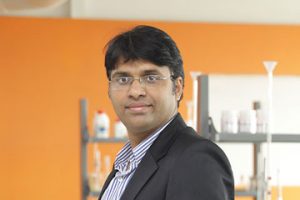 Nanomaterials are an increasingly important product of nanotechnologies with applications in medicine/healthcare, electronics, environmental health, technology and industry.
Nanomaterials are an increasingly important product of nanotechnologies with applications in medicine/healthcare, electronics, environmental health, technology and industry.
“The reason so many disciplines like chemistry, physics, engineering and biology are looking at this field is the exciting properties of materials at a nanoscale. It has broad application potential including bio-imaging diagnosis in the health sector.” says Dr. Nimai Mishra, Associate Professor of Chemistry at SRM AP.
Through his own research, Dr. Mishra, has attempted to develop a synthesis technique that can produce blinking free semi-conductor nanoparticles for increased energy savings in the use of light emitting diodes (LED), lasers and solar cells.
“For the past decade there has been considerable work in this field and in 2013 as a post-doctoral fellow at Los Alamos Lab in the U.S. I began to focus exclusively on this research.”
In April 2019, at the 2nd Global Outreach Research and Education Summit held at HITEX Exhibition Centre in Hyderabad Dr. Nimai Mishra’s work in nanomaterials was recognized with the “Young Researcher in Chemistry” award – an initiative of the Global Outreach Research & Education Association (GOREA).
Dr. Mishra, delivered a talk on “Nanochemistry: Impact in Device Fabrication” specifically, the control synthesis of nanoparticles via colloidal chemical route and their application in solar cell and LEDs.
For Dr. Mishra, whose education and research background includes IIT-Madras, NUS, Singapore, Los Alamos National Lab, USA and IIT-Genova, Italy, the summit was an opportunity to share ideas on how to meet challenges in higher education research.
At the summit, attended by over 100 delegates from all over the world, the papers presented were a diverse mix of subjects from materials science, digital dentistry, blockchain technology and the booming smart classroom market in India.
The Global Outreach Research & Education Association (GOREA) is a charitable foundation established in 2018 to promote technical advancement, entrepreneurship and skill development. GOREA achieves this through a global association of educationists, technologists, industrialists, business leaders and policymakers working towards the growth of research & education industry.
Earlier in February at IIT-BHU in Varanasi Dr. Mishra was awarded the Young Scientist Award” at the International Conference of Functional Nanomaterials (ICFNM-2019)” organized by IIT-BHU along with IIT-Guwahati and Society of Interdisciplinary Research in Material and Biology (SIRMB). The shortlisted six candidates were faculty from IIT, NIT, DBT Institute.
Of the event, Dr. Mishra said, “Speakers were from IIT, IISER and IISc. The good news is that most were aware of and admire the broad ambitious vision of the SRM AP university management.”
- Published in News, Research News
Dr. Nimai Mishra’s work in Nanomaterials recognized by leading education research institutes.
 In April 2019, at the 2nd Global Outreach Research and Education Summit held at HITEX Exhibition Centre in Hyderabad Dr. Nimai Mishra’s pioneering work in nanomaterials was recognized with the “Young Researcher in Chemistry” award, an initiative of the Global Outreach Research & Education Association (GOREA).
In April 2019, at the 2nd Global Outreach Research and Education Summit held at HITEX Exhibition Centre in Hyderabad Dr. Nimai Mishra’s pioneering work in nanomaterials was recognized with the “Young Researcher in Chemistry” award, an initiative of the Global Outreach Research & Education Association (GOREA).
At the summit, attended by over 100 delegates from all over the world, Dr. Mishra, delivered a talk on “Nanochemistry: Impact in Device Fabrication” specifically, the control synthesis of nanoparticles via colloidal chemical route and their application in solar cell and LEDs.
Through his research, Dr. Mishra, Associate Professor of Chemistry at SRM AP, has attempted to develop a synthesis technique that can produce blinking free semi-conductor nanoparticles for increased energy savings in the use of light emitting diodes (LED), lasers and solar cells.
“For the past decade there has been considerable work in this field and in 2013 as a post-doctoral fellow at Los Alamos Lab in the US I began to focus exclusively on this research. The technology has wide application potential including bio-imaging diagnosis in the health sector.”
For Dr. Mishra, whose education and research background includes IIT-Madras, NUS, Singapore, Los Alamos National Lab, USA and IIT-Genova, Italy, the summit was an opportunity to share ideas on how to meet challenges in higher education research.
The papers presented at the summit were a diverse mix of subjects from materials science, digital dentistry, blockchain technology and the booming smart classroom market in India.
The Global Outreach Research & Education Association (GOREA) is a charitable foundation established in 2018 to promote technical advancement, entrepreneurship and skill development. GOREA achieves this through a global association of educationists, technologists, industrialists, business leaders and policymakers working towards the growth of research & education industry.
Earlier in February at IIT-BHU in Varanasi Dr. Mishra was awarded the Young Scientist Award” at the International Conference of Functional Nanomaterials (ICFNM-2019)” organized by IIT-BHU along with IIT-Guwahati and Society of Interdisciplinary Research in Material and Biology (SIRMB). The shortlisted six candidates were faculty from IIT, NIT, DBT Institute.
Of the event, Dr. Mishra said, “Speakers were from IIT, IISER and IISc. The good news is that most were aware of the work being done at SRM AP and admire the broad ambitious vision of the university management.”
- Published in News, Research News
Dr. Thondamal to set up joint biological research facility at leading national lab in Hyderabad
May, 2019: Following discussions between SRM APs Biology research team (initiated by SRM AP Pro VC Prof. Narayana Rao and Dr. S. Chandrasekhar, Director CSIR-IICT, Hyderabad) and the Applied Biology division of CSIR-IICT, Dr. Manjunatha Thondamal, Assistant Professor, Department of Biological Sciences at SRM AP, was invited to establish a C. elegans facility at IICT campus and train the scientists/students.
- Published in News, Research News
Dr. Shailender Swaminathan proposes overhaul in insurance and medical services in India’s healthcare sector.
3rd August, 2019, Madras School of Economics, Chennai: The Chennai International Centre (an organization providing a platform for intellectuals and luminaries to share transformational ideas) invited an expert panel to talk on Indian Healthcare Services. The panel members comprising Dr. Shailender Swaminathan (Health Economist, Researcher, Associate Dean – SLABS, SRMU – AP, Amaravati), Dr. Keshav Desiraju (Former Health Secretary, Government of India), Dr. Soumya Swaminathan (Chief Scientist, WHO) discussed the significance of a holistic approach in the healthcare sector with moderator Dr. Nalini Krishnan, Director, REACH – Resource Group of Education and Advocacy for Community Health. Panelists addressed the inaccessibility of medical facilities in India stemming primarily from a lack of government funding, high cost of drugs and the low literacy rate. The panel also recognized how this inaccessibility leads to poor utilization of technology and low insurance penetration.
“How India is able to fund healthcare five years from now is of significance,” opined Dr. Shailender Swaminathan, citing the US healthcare system, “The U.S. aimed at funding healthcare services of people over 65 years through the contribution of younger citizen and taxpayers. This previously successful U.S. model is on the verge of failure as the cost of drugs increased at a higher pace exhausting the funds.”
Pointing out that policies must be directed towards reducing the poverty rate in India to suffice for increasing healthcare expenses, Dr. Swaminathan added that “High expenditure on healthcare services leaves no funds for purchasing basic consumption goods, further pushing citizens below the poverty line. “
He explained that insurance policies in India cover only hospitalization bills whereas outpatients (patients who do not require hospitalization) are unable to pay the daily medical expenses. This lack of outpatient insurance drives up insurance costs, as minor health issues are not treated, leading to eventual hospitalization of the patient.
According to Dr. Swaminathan an integrated approach towards healthcare would prompt the government to provide free diagnostic and treatment services of high quality to outpatients. The panel concluded that the government must focus on primary healthcare services, prevention of diseases, insurance inclusivity and healthcare promotion.
Healthcare panel in discussion: https://www.youtube.com/watch?v=ShU1nH1w0Fo
- Published in News, Research News
URC backs computational & experimental research. New R&D collaborations proposed
Amaravati, 7th August 2019: At the University Research Council meeting held on campus, and presided by Dr. P. Sathyanarayanan, Founder and President of the board, a renewed commitment was made to research of national significance such as energy conservation and sustainability.
An illustrious, distinguished and accomplished group of academicians and scientists provided direction and mentorship to the faculty members and research scholars. The council comprises Prof K. Satyanarayana – Director, IIT Tirupati, Prof. U.B. Desai – Director, IIT Hyderabad, Prof. P. Appa Rao – Vice Chancellor, University of Hyderabad, Prof. Gautam R. Desiraju – IISc, Bangalore, Dr. S.R. Rao – former Senior Adviser, Department of Biotechnology, Government of India, Prof. B.S. Murthy – IIT Madras, Chennai, Dr. Padmanabham – Director, ARCI, Hyderabad, Prof. B.V.R. Chowdari – Senior Executive Director, Nanyang Technological University, Singapore and Prof. D. Narayana Rao – Pro-Vice Chancellor, SRM University – AP, Amaravati.
The meeting commenced with an opening presentation by Prof. D. Narayana Rao, Pro-Vice Chancellor, SRM AP, Amaravati highlighting the areas of research currently undertaken and proposed to carry out by the University’s 107-member faculty. The Chairman of the Research Council, Dr. V. K. Saraswat – Member of NITI Aayog, addressed all the members through a video call and advised them on the need and development of research activities. Dr. Saraswat also highlighted the importance of aligning research programs with the national agenda.
Vice Chancellor, Dr. Jamshed Bharucha emphasised SRM AP Amaravati’s focus on societal impact through original research in an interdisciplinary environment. The new research lab building and the X-Labs will facilitate these initiatives. Faculty Members made presentations on the current as well as proposed research activities
The council commended the quantum and quality of work already done by SRM AP Amaravati in just two years of inception. Members pointed out that the kind of MOUs and collaborations effected with different organisations are crucial for the faculty to be able to sustain research. Specific appreciation was about Hydrogen Powered Train (Jal-Janak Rail) being developed in collaboration with Integral Coach Factory (ICF) of the Ministry of Railways, SRM-Amara Raja Center for Energy Storage Devices. Special mention was made to the sports science centre as it is often an overlooked area.
Prof. P. Appa Rao offered that the experimental facilities of University of Hyderabad can be accessed by the faculty members of SRM University-AP, Amaravati. Dr. Padmanabham invited the faculty members of SRM University-AP, Amaravati to establish collaborations with ARCI, Hyderabad and make use of the state-of-the art experimental facilities available at ARCI.
Commenting on the occasion, Dr. Kasthurirangan Gopalakrishnan, Associate Dean – Research said, “The inputs provided by the council have not only been encouraging but have also been extremely insightful. They have provided diligent inputs and guidance. Our faculty found this experience extremely motivating.”
- Published in News, Research News
“Cost is the factor that connects all the dots.” Dr.Rajendran on the future of bioenergy
“The Intergovernmental Panel on Climate Change (IPCC) suggests the temperature rise should be limited to 1.5°C by the end of this century for the world to survive, “says Dr. Karthik Rajendran, Assistant Professor, Department of Environmental Science. “For this, we need to reduce the emission by almost 50% of 2010 levels.” He further points out that while we may produce electric cars instead of petrol cars, electricity from solar and wind instead of coal, natural gas biologically as biogas instead of shale gas one question is at the center of these technologies – cost.
Dr. Rajendran’s quest to understand the factors influencing commercial viability of bioenergy systems began in Chennai during his bachelors’ thesis on hydrogen production leading subsequently to numerous lab simulations to understand the bottlenecks of commercialization.
On techno-economic analysis as an early indicator of commercial viability
Techno-economic analysis is an examination of various specifications of the technology at its inception stage when it is merely an experiment in a conical flask. “We analyze components on basis of all aspects of technology, economic feasibility, environmental sustainability, market realization and social integration. We can identify bottlenecks early on that hasten the technology out of the laboratory towards commercialization. This enables us to more accurately predict the fate of bioenergy/bio-based product developed out of laboratory.”
The role of institutional and government support
“In my Masters studies at UB Sweden I realized not all technologies being developed in labs are successful and that economics is not the only component that hinders commercialization. We need good institutional and governmental policy, including technical support, to advance such clean energy systems. This is when I started working on integrating technology, economics, and government policy. I compared different European technologies including biogas, electric cars, solar, and wind to understand the role of state/government subsidies towards green technology development. What I found was that electric car technologies for example do little to prevent C02 emissions, yet they receive more incentives from the government compared with other renewable energy systems. It’s about the source of electricity. Be it coal or wind plant if it’s not a green electricity source it is not a green vehicle.”
The science of energy waste conversion
Dr. Karthik Rajendran’s initial research on bioenergy production from waste looked specifically at hydrogen from algae. He currently focuses on bioenergy with carbon capture and utilization with the cost factor being the main parameter. Dr. Rajendran explains how this works. “For example, due to long term storage issues excess solar or wind energy spills over and is wasted. This excess electricity is converted to hydrogen through electrolysis. Then the hydrogen can be combined with CO2 from a bioenergy system to produce methane. This is known as Sabatier reaction. In Europe this research is happening with an aim to convert existing gas grids to a green gas grid by 2050.”
Several of Dr. Rajendran’s published papers examine electro fuels, circular bio economy and techno-economic analysis.
- Published in News, Research News
Paradigm shift to sustainable systems
Dr. Lakhveer proposes to reduce the cost of bioreactors
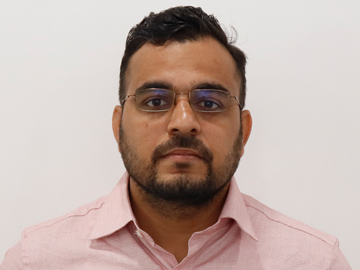 Reputed publishing house Elsevier has published the illuminating research work of Dr. Lakhveer Singh, Assistant Professor, Department of Environmental Science. The book named Bioreactors: Sustainable Design and Industrial Applications in Mitigation of GHG Emissions (1st Edition), is co-edited by Durga Mahapatra, Oregon State University, USA, Scientist and Dr Abu Yousuf, Assistant Professor, Shahjalal University of Science and Technology, Bangladesh.
Reputed publishing house Elsevier has published the illuminating research work of Dr. Lakhveer Singh, Assistant Professor, Department of Environmental Science. The book named Bioreactors: Sustainable Design and Industrial Applications in Mitigation of GHG Emissions (1st Edition), is co-edited by Durga Mahapatra, Oregon State University, USA, Scientist and Dr Abu Yousuf, Assistant Professor, Shahjalal University of Science and Technology, Bangladesh.
Dawn of the 21st century has witnessed a solemn crisis in petroleum-derived fuels, consequently causing a major setback in chemicals/bio-products industries. Also, the researchers identify that the problem of climate change needs to be addressed by reducing the emission of greenhouse gases (GHGs). Dr. Lakhveer states, “To cope up with soaring energy demands, the present generation requires a paradigm shift from fossil-based resources to renewables and sustainable systems which accentuates the necessity of bioreactors for employing bioenergy and bio-products recovery”.
Presently, sophisticated bioreactor technologies have resulted in towering industrial production significantly contributing to the global economy and benefiting human life. Bioreactors have a substantial role in building a sustainable economy and providing food, feed, energy and other basic amenities for a quality life. Numerous bioreactors have evolved over time through sustainable research targeting commercialization.
A bioreactor is a vessel-like device that provides a uniform background for microorganisms to grow. It maintains an uninterrupted balance in the biochemical reactions carried out by these microorganisms to produce the desired metabolites. The applications of bioreactors extend to biomass production such as microalgae, single-cell protein, and yeast. For metabolite formation like organic acids, ethanol, antibiotics, aromatic compounds, and pigments, bioreactors are absolute. It also contributes to transforming substrates like steroids along with supplementing to production of both the intra and extracellular enzymes.
Recently, Dr Singh has developed an innovative cost-effective hybrid bioelectrochemical reactor (15.0 L) in collaboration with Oregon State University, USA, capable of generating efficient hydrogen at a cost less than $2/kg of H2 from lignocellulose hydrolysates or wastewater.
“In our research we have developed numerous types of bioreactors ranging in size from 5.0 to 100 L. A few examples are immobilized up-flow bioreactor, two-stage thermophilic and mesophilic fermenter, sequential dark and photobioreactor as well as hybrid bioelectrochemical reactor for bioenergy production and valuable products recovery from various industrial and agriculture waste. “ informs Dr. Lakhveer.
The book “Bioreactors” presents and compares the foundational concepts, state-of-the-art design and fabrication of bioreactors. Solidly based on theoretical fundamentals, it examines various aspects of the commercially available bioreactors, that includes construction, fabrication, design, modeling, simulation, development, operation, maintenance, management, and target applications for biofuels production as well as bio-waste management. Emerging issues in commercial feasibility are explored in the book along with covering the constraints and pathways for upscaling. It also carries out rigorous techno-economic assessment.
“This book provides researchers and engineers in the biofuels and waste management sectors a clear understanding of the actual potential of various advanced bioreactors for their requirements. It allows them to embark on informed decisions while selecting the appropriate technology models for sustainable systems development and commercialization”, says Dr. Lakhveer.
Advancing his work, Dr Singh is developing efficient and economical bioreactors for commercial applications in the energy and water sectors. In this regard, three international patents have been filed. In the next few months, two more of his books are to be published by American Chemical Society, ACS and Elsevier. The books will emphasize issues and frontiers of reactors technology such as operation, novel design, cost analysis, novel electrodes, nano catalytic materials and other extended applications of bioreactors.
- Published in News, Research News
Small-World Wireless Sensor Network to Help Making Smart Applications for Industries
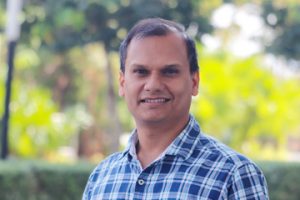 Dr Om Jee Pandey, Assistant Professor, Department of Electronics and Communication Engineering, has recently published two papers in renowned IEEE journals. His paper “Secrecy Performance Analysis of Two-way Relay Non-Orthogonal Multiple Access Systems” was published in IEEE Access Journal, having an impact factor: 4.06. Whereas, “Fault-Resilient Distributed Detection and Estimation over an SW-WSN Using LCMV Beamforming” was published in IEEE Transactions in Network and Service Management (Impact factor: 4.682). The study was done in associations with Prof. Rajesh M Hegde, Department of Electrical Engineering, IIT Kanpur and Prof. Ha H. Nguyen, Department of Electrical and Computer Engineering, University of Saskatchewan, Saskatoon, Canada. His research was focused on developing efficient Wireless Sensor Network services in small-world models. The proposed research can be applied in developing many state-of-the-art applications in the areas related to healthcare systems, climate-smart agriculture, intelligent transportation, home automation, manufacturing, smart utilities, and industries etc.
Dr Om Jee Pandey, Assistant Professor, Department of Electronics and Communication Engineering, has recently published two papers in renowned IEEE journals. His paper “Secrecy Performance Analysis of Two-way Relay Non-Orthogonal Multiple Access Systems” was published in IEEE Access Journal, having an impact factor: 4.06. Whereas, “Fault-Resilient Distributed Detection and Estimation over an SW-WSN Using LCMV Beamforming” was published in IEEE Transactions in Network and Service Management (Impact factor: 4.682). The study was done in associations with Prof. Rajesh M Hegde, Department of Electrical Engineering, IIT Kanpur and Prof. Ha H. Nguyen, Department of Electrical and Computer Engineering, University of Saskatchewan, Saskatoon, Canada. His research was focused on developing efficient Wireless Sensor Network services in small-world models. The proposed research can be applied in developing many state-of-the-art applications in the areas related to healthcare systems, climate-smart agriculture, intelligent transportation, home automation, manufacturing, smart utilities, and industries etc.
In order to develop efficient Wireless Sensor Network (WSN) services, several methods have been proposed for node localization, clustering of sensor nodes, new routing algorithms, adaptive duty cycles, usage of mixed-transmission models, placement of intelligent gateways, usage of mobile elements, and bypassing holes. However, the introduction of small-world characteristics in a WSN has hitherto not been used in this context. A small-world network is typically characterized by a low average path length and high average clustering coefficient and has been widely used to model social networks. However, small world models have not been used in the development of WSN. The primary objective of this research is to develop small world models for WSN services such as sensor node localization, data gathering, data fusion, network lifetime maximization, energy-balancing, reduced data transmission delay, time synchronization, energy-harvesting, and robust distributed detection and estimation. A small world WSN reduces the number of hops required for data transmission, and maximal utilization of sensor nodes closer to the sink. Other advantages of small world WSN include efficient bandwidth utilization, increased network lifetime, and fast convergence of event detection and parameter estimation. Small world WSN developed in tandem with novel routing strategies leads to improved WSN services for various applications.
In WSNs, sensor devices transfer the data cooperatively using multiple hops over a network. Multiple hops required for data transmission over a WSN leads to reduced network performance in the context of device localization, energy efficiency, energy balancing, data latency, speed of event detection and parameter estimation, and network robustness. This is because of poor distance estimation between sensor device pairs, maximum utilization of sensor devices closer to the sink, and a short radio range of sensor devices. Hence, the primary focus of this research work is to reduce the number of hops required for data transmission. In this context, Small World Characteristics (SWC) can be introduced in a WSN, leading to a small world WSN (SW-WSN). An SW-WSN is a well-connected network with reduced hop counts between node pairs.
Small world phenomena were first observed by Stanely Milgram in social connectivity of people. Later, it came out as a theory of “six degrees of separation”. Six degrees of separation claims that all people are six, or fewer, social connections away from each other. This theory is also known as the 6 Handshakes rule. Further, small-world phenomena have been investigated in graphs. Subsequently, SWC is observed in wireless networks. In general, small world WSNs (SW-WSNs) are characterized by low Average Path Length (APL) and high Average Clustering Coefficient (ACC). For an undirected WSN with N nodes, representing a regular network, the APL increases linearly with the number of nodes present in the network. On the other hand, in a WSN having SWC the APL, between two randomly selected nodes grows proportionally to the logarithm of the number of nodes in the network. “WSNs are spatial graphs, where links are created using radio connectivity. There is a limit on the radio range of a sensor node, hence in such networks, the long-range connections are generally absent. Thus, these networks are clustered, but they do not experience small-world phenomena. Hence, the primary focus of this work is to develop SW-WSN using various methods leading to efficient WSN services” explained Dr Pandey.
Dr Pandey is now busy to take the studies further. His future projects include-
• Small World WSN (or SW-WSN) Development for Smart Healthcare.
• Cognitive SW-WSN for Energy-Efficient CPS and IoT applications.
• Climate Smart Agriculture using Cognitive SW Characteristics.
• Low-Latency and Intelligent Transportation over small world CPS.
• Multi Sensor Fusion over SW-WSN for CPS/IoT Applications.
• Information and Context Quality in WSN, IoT and CPS Networks.
- Published in ECE NEWS, News, Research News
Scaling up waste remediation through nanoenzymes
Dr. Lakhveer Singh on clean and affordable bioelectrofuels
“Nanoenzyme as a cutting-edge innovation that makes bioelectrofuels more affordable and efficient for sustainable future”
Dr. Lakhveer Singh, Assistant Professor, Department of Environmental Science, publishes a paper on “Bioelectrofuel Synthesis by Nanoenzymes: Novel Alternatives to Conventional Enzyme” in the journal “Trends in Biotechnology” with an Impact factor of 13.74. The paper discusses the vital role of nanozymes to advance Bioelectrochemical cells platforms for improved bioelectrofuels generation and waste remediation. Nanozymes are nanomaterials with intrinsic enzyme-like characteristics that have gained importance over the past decade because of its capability to address the limitations of natural enzymes – low stability, high cost, and difficult storage.
Waste recycle and reuse is the need of the hour, and are the most prioritized research in the 21st century. Innovation with present-day technologies as “Bioelectrochemical cells” with a focus on waste remediation, recovery and reuse is believed to strengthen the resource security along with building a sustainable and resilient society. “In order to mitigate several challenges pertaining to the ineffectual performance of microbial catalysts in electrode frameworks, nanomaterial-based nanozymes exhibit capabilities to boost their efficiency by enhancing microbial connection and interaction with electrode surface.”, explains Dr. Lakhveer.
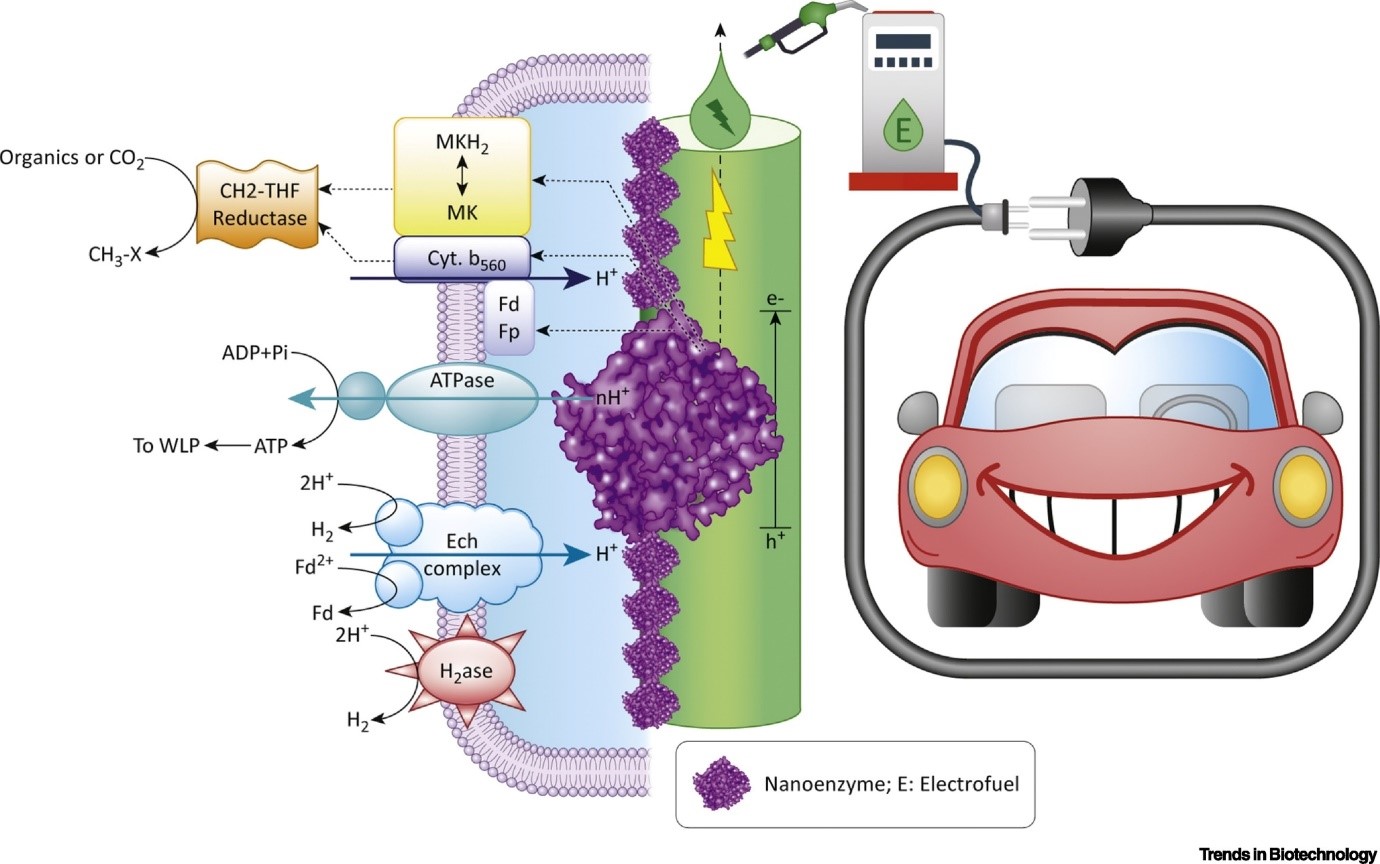 Mechanisms of Nanoenzyme–Microbe Interaction That Facilitate Bioelectrofuel Production
Mechanisms of Nanoenzyme–Microbe Interaction That Facilitate Bioelectrofuel Production
THe further says, “The application of nanoenzymes to replace natural enzymes for improved bioelectrofuel production has long been under-rated. Recent advancements in bioinspired mimetics have led to applying nanoenzymes as a favourable bifunctional or multifunctional tool to achieve large turnover frequencies and high stability in bioelectrochemical platforms. Despite a few technical impediments, nanoenzymes guarantees clean and affordable bioelectrofuels”.
For long-term operations, biocompatibility is observed to remain a challenge associated with nanoenzymes. This is because of the concurrent shape change of nanoparticles during its gradual decomposition that often alters their electrocatalytic behaviour in response to prolonged operation, thus adversely affecting the electrofuel productivity. This paves the path for the future research work of Dr. Lakhveer which will focus on the preparation of nanoenzymes based electrocatalysts with doping of plasmonic or paramagnetic noble metals. This will counter the issue of mass loading and slow down the gradual decomposition process to ensure uninterrupted bioelectrofuels supply during long-term operation.
- Published in News, Research News
Cost-effective shield against Coronavirus
Dr. Panchagunula Jayaprakash designs an improved alternative to regular masks
Dr. Panchagunula Jayaprakash, Assistant Professor, Department of Mechanical Engineering, has designed a FACE SHIELD embedded with 3D printing technology. During this pandemic that has led to an unprecedented global crisis, this face protection devised to protect users from the Novel Coronavirus, is made available at the minimum rate of Rs. 20 each. The major drawback of the commercially available Face Shields for engineering applications is its heavy weight which causes discomfort if worn for a longer period of time. This face mask that uses 3D printing technology alleviates the limitations of the regular masks currently used by doctors, policemen, and journalists.
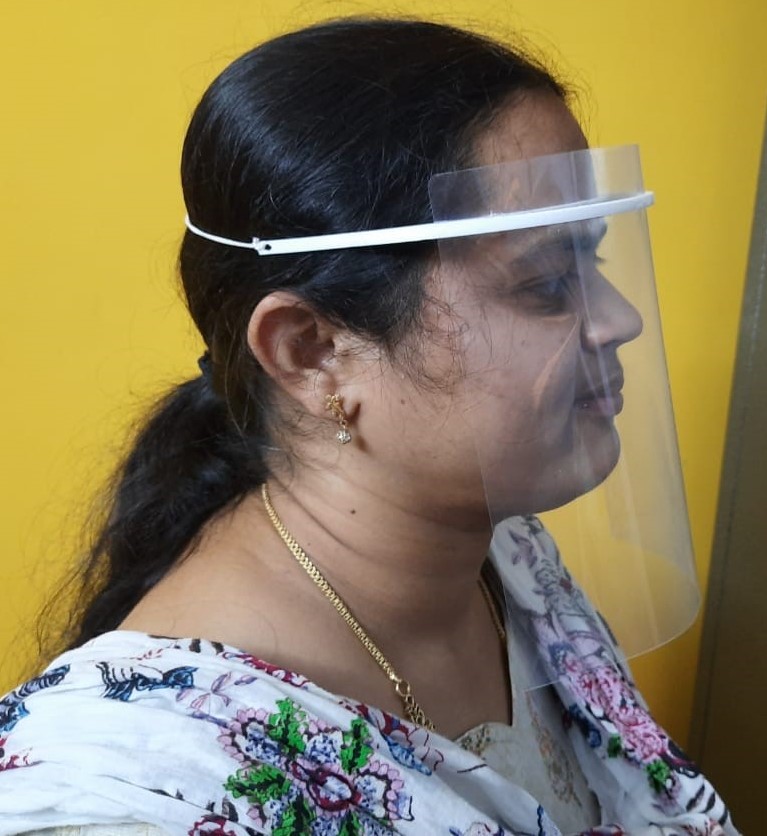 Head mounted Face Sheild
Head mounted Face Sheild
“With the advent of Covid-19, and due to the shortage of personal protective equipment, the health workers such as Doctors, Sanitary staff and Police are also getting infected. As they are the backbone of the society, I thought of designing a light weight Face Shield using 3D Printing (3DP) or Additive Manufacturing technique. The rudimentary advantages of 3D printing technology is the design flexibility and less lead time to manufacturing. “, explains Dr. Jayaprakash.
 Creation of CAD model
Creation of CAD model
 3D Printing
3D Printing
The regular masks barely cover the nose and mouth, whereas the Face Shield will be able to protect the eyes, mouth, nose, and ears so that one cannot get infected by the virus. Some of the medical and police personnel who use the regular masks suffer from facial irritation, making the Face Shield a comfortable and more effective alternative for all government officials on Covid-19 duty.
 Physical component
Physical component
Dr. Jayapraksh further says, “While manufacturing the Face Shield, 3D printing technology is used for designing a headband, upon which a 100 micron thick transparent plastic sheet is attached to ensure superior protection against the virus. It prevents air, dust, and liquids that are contaminated to come in contact with people. Also, there are no probable side effects on using the mask. If the government approves of its marketing, the face mask can be distributed among the public to prevent the widespread of Novel Coronavirus.”
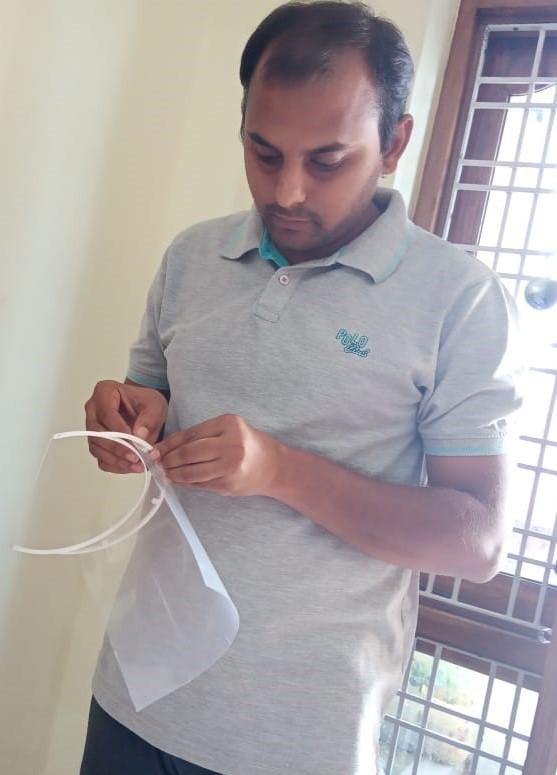 OHP sheet assembly
OHP sheet assembly
The management of SRM AP, Andhra Pradesh applauds Dr. Jayaprakash on designing the mask after relentlessly working on it for several days. Prof. Narayana Rao, Pro Vice-Chancellor of the University, has written to Adimulapu Suresh, Minister of Education, Andhra Pradesh, and Alla Kalikrishna Srinivas, Deputy Chief Minister of Andhra Pradesh, Minister for Health, Family Welfare and Medical Education, Andhra Pradesh, highlighting the importance of the facial cover and the many ways it can be regarded as a boon to the society as a whole. He said that the Face Shield would be beneficial to millions of students who would be attending regular classes once the educational institutions reopen.
- Published in Mechanical Engineering NEWS, News, Research News


